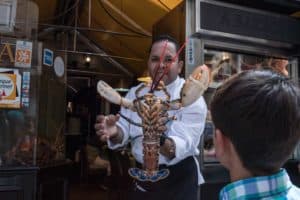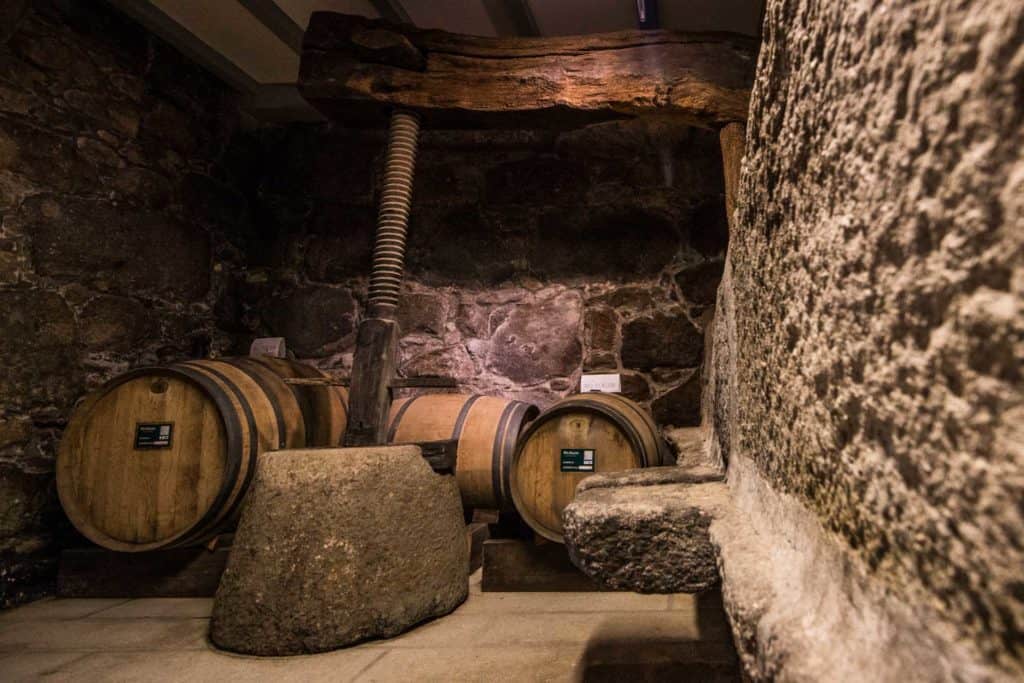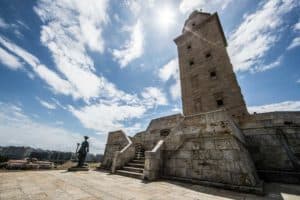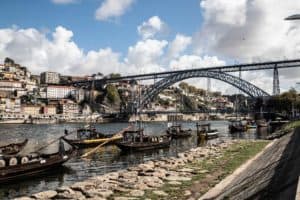Around old-town Santiago de Compostela
Once you arrive in Santiago de Compostela, we recommend spending time wandering through the charming streets of the old town. You’ll find countless cozy restaurants tucked away in tiny alleyways where you can savor local wine and tapas. Be sure to explore the shops selling Azabache, the protective black stone of the Camino de Santiago. It makes for a meaningful souvenir to take home for yourself or your loved ones.
Below, we’ve highlighted some of our favorite cultural stops in Santiago de Compostela that you won’t want to miss after completing your Camino journey.
Abastos Market
The Abastos Market, or Mercado de Abastos, began in 1874 with people setting up shops in pavilions made of iron and glass to trade their local Galician products in the town center. The market has been remodelled many times throughout history, but the last remodel in 1945 transformed the market into what it is today. The market sells a variety of products, such as vegetables, fruits, meat, fish and many other local products. You can even order fresh seafood in the morning to be prepared for your lunch in the afternoon. Following the Cathedral, this market is the most visited place in Santiago de Compostela, so you won’t want to miss it!

Alameda Park
The most famous park in Santiago de Compostela is Alameda Park, located just outside the old town. Upon entering, you are greeted by the memorial statue of Spanish sisters, Maruxa and Coralia Fanino Ricart. The statue depicts the sisters as they would have looked, arms linked, strolling through their favorite park in the 50s and 60s, wearing vibrant colors. Despite their colorful appearance and warm gestures, their solemn faces reflect a troubling story. You can read about their history and how they became a symbol of the fight against oppression here. As you leave the Two Marias behind, a beautiful, tree-lined trail takes you to a magnificent view of the Cathedral.

Cathedral de Santiago de Compostela Museum
Visit the Cathedral Museum to uncover the fascinating origins of this UNESCO World Heritage site and its pivotal role in transforming the Camino de Santiago into one of the most iconic pilgrimages in Europe and beyond. Explore the rich history of the Cathedral through its remarkable collection of artifacts. You’ll not only gain insight into the centuries-old traditions of the Way, but also have the unique opportunity to climb the medieval tower for a unique bird’s-eye view of pilgrims arriving in the iconic Plaza Obradoiro.
 The Museum of Pilgrimage and Santiago
The Museum of Pilgrimage and Santiago
This museum, dedicated to the birth and evolution of the city of Santiago de Compostela focuses heavily on the role that pilgrimage has played in developing the city. The museum’s regular exhibit lets visitors discover what it would have been like as a medieval pilgrim on the Camino hundreds of years ago. The museum is also home to various art exhibitions that feature photography and illustrations related to the Camino de Santiago. We highly recommend that you visit this cultural center.
 Galician Folk Museum
Galician Folk Museum
This museum was created in 1976 for the promotion and conservation of Galician culture. It showcases five routes by which you can learn about and appreciate Galicia, the sea, countryside, trades, places and everyday objects. In this museum as well, you will find rotating art exhibitions from local Galician artists.
Day Trips from Santiago de Compostela
If your schedule allows, there are many interesting landmarks you can explore not far from Santiago de Compostela. We are more than happy to advise you on how to best plan these excursions after your pilgrimage.
Finisterre and Muxía

Finisterre and Muxía are both significant pilgrimage sites in their own right. In fact, many pilgrims choose to continue their journey here after reaching Santiago de Compostela.
Finisterre, meaning “End of the Earth,” was believed until the Middle Ages to be the westernmost point of the known world. Pilgrims would arrive at the rugged coastline and collect a scallop shell as a symbol of completing their journey. The dramatic cliffs and sweeping views over the Atlantic Ocean make this a truly awe-inspiring destination.
Muxía, on the other hand, holds deep spiritual significance due to the legend that the Virgin Mary arrived here in a boat made of stone to support St. James in his mission. It is said that fragments of her boat remain on the shoreline as petrified stones, believed to hold special healing powers. Muxía is also home to the sacred Virxe de Barca Sanctuary, originally a pre-Christian Celtic shrine. The current structure, built in the 17th century, stands on the site where a hermitage was first erected in the 12th century.
Sitting on the cliffs and watching the waves crash against the shore is the perfect moment for reflection. Before you leave, don’t miss the chance to take part in the local Galician tradition of walking under the “healing stone” eight times to bring good luck and fortune.
If you’re looking to extend your Camino adventure, we can arrange a self-guided “Walk to the End of the World” that leads you from Santiago to the unforgettable landscapes of Finisterre and Muxía.
A Coruña
A Coruña is a vibrant coastal city, just a half-hour train ride or an hour’s drive from Santiago de Compostela. Known for its rich maritime history, it rose to prominence as a major commercial port and one of Galicia’s primary fishing hubs. A Coruña offers something for everyone, be it history, culture, or simply a peaceful seaside escape.
The city’s historic quarter sits on a scenic peninsula, home to the iconic Tower of Hercules, the world’s oldest functioning Roman lighthouse. Climb its 234 steps for breathtaking views of the Atlantic Ocean. We also recommend wandering through the charming old town, from the grand Plaza María Pita to the narrow, winding streets filled with cozy cafes, unique shops, and excellent wine bars.
If you have extra time, take a short trip to the nearby fishing villages of Santa Cruz, just 30 minutes from the city. The Castle of Santa Cruz, perched on a small island and accessible by a footbridge, was built in the 16th century to defend the port of A Coruña.
Porto, Portugal
Porto, Portugal is just a 3.5-hour drive or a 4-hour bus ride from Santiago de Compostela. If you have the chance, we highly recommend an overnight stay in this vibrant and historic city.
Although Porto is Portugal’s second-largest city after Lisbon, it feels more intimate, with narrow, cobbled streets that meander along the banks of the River Douro. The city’s history dates back to the Celts, who first established the port, followed by Roman occupation in the 4th century. With such a rich past, Porto offers endless sights to explore, from historic bridges and grand palaces to ancient towers, cathedrals, and bustling markets. And for Harry Potter fans, a visit to the iconic Livraria Lello bookstore, the inspiration of Hogwarts, is a must.
No trip to Porto is complete without indulging in local delicacies, such as the famous pastéis de nata, Portugal’s beloved custard tart, and bacalhau à Brás, a traditional salted cod dish. Pair it all with a glass of sweet Port wine, the city’s signature drink. For true wine lovers, we recommend a tasting tour in Porto’s historic wine cellars or a day trip to the stunning Douro Valley, where the famous Port grapes are grown and harvested.
Porto, a city that blends history, culture, and gastronomy, is well worth the journey from Santiago.
Vineyards in Ribeira Sacra and Rías Baixas
In Spain, you’re never far from a vineyard, and Santiago de Compostela is no exception. A 45-minute drive toward the coast takes you to Rías Baixas, while a journey of just an hour and a half brings you to Ribeira Sacra. Both regions are celebrated for their exceptional wines, notably Mencía reds and Albariño and Godello whites.
Spain has been producing wine for as long as it has been inhabited and is the world’s third-largest wine producer, following France and Italy. Thanks to its diverse geography, Spain offers an incredible variety of wines, each region boasting its own specialties.
As you walk the Camino Francés, you’ll pass through some of northern Spain’s most famous wine regions. You first traverse Navarra, known for its Garnacha reds. Arriving in Logroño, you enter La Rioja, one of Spain’s most prestigious wine regions, famous for Tempranillo and oak-aged reds. Further along in León, you’ll be near areas known for producing sparkling wines. As you approach Santiago de Compostela, you enter Galicia, renowned for its white wines.
For a perfect wine experience, consider a day tour to Ribeira Sacra from Santiago de Compostela. Alternatively, rent a car and take a scenic drive along the Galician coast, stopping in charming fishing villages and soaking in breathtaking beach views. Visit local wineries, learn about the winemaking process, and pair a crisp Albariño with a delicious seafood meal, an unforgettable combination.
We also recommend visiting the picturesque town of Cambados, famous as the home of Albariño wine. Situated along the coast, Cambados hosts an annual Albariño Wine Festival each August. Upon arrival, you’ll receive a wine glass necklace, allowing you to roam from stall to stall, tasting the region’s finest Albariño and savoring delicious Galician tapas.
Whether you’re a wine enthusiast or simply looking to indulge in the flavors of Galicia, a wine adventure from Santiago is an experience not to be missed.
BEFORE THE WALK, WE TALK
This is STEP 1
The journey to Santiago de Compostela is one of many steps. We feel strongly that learning more about your expectations should be the first. To make sure that Andaspain is an ideal fit for the adventure ahead tell us when you can be reached by phone and we will call you up. If you prefer to contact us, scroll all the way to the bottom of this page to find our number and email address.






